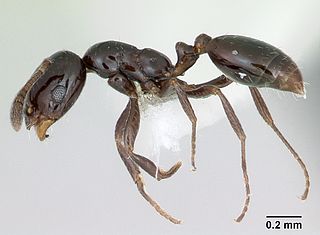Monomorium santschii is a species of ant that is native to Tunisia. The most famous species in the genus Monomorium is the highly invasive pharaoh ant, Monomorium pharaonis.

The pharaoh ant is a small (2 mm) yellow or light brown, almost transparent ant notorious for being a major indoor nuisance pest, especially in hospitals. The pharaoh ant, which is a cryptogenic species, has now been introduced to virtually every area of the world, including Europe, the Americas, Australasia and Southeast Asia. It is a major pest in the United States, Australia, and Europe.

A species that is extinct in the wild (EW) is one that has been categorized by the International Union for Conservation of Nature as known only by living members kept in captivity or as a naturalized population outside its historic range due to massive habitat loss.

Monomorium bidentatum is a species of ant in the subfamily Myrmicinae. It is endemic to two South American countries, Chile and Argentina.
Monomorium effractor is a species of ant in the genus Monomorium. It is native to India.

Monomorium is a genus of ants in the subfamily Myrmicinae. As of 2013 it contains about 396 species. It is distributed around the world, with many species native to the Old World tropics. It is considered to be "one of the more important groups of ants," considering its widespread distribution, its diversity, and its variety of morphological and biological characteristics. It also includes several familiar pest species, such as the pharaoh ant and the flower ant.
Monomorium hospitum is a species of ant in the genus Monomorium. It is native to Singapore.

Monomorium noualhieri is a species of ant endemic to Algeria.

Monomorium pergandei is a species of ant in the genus Monomorium. It is native to the United States. The species is named after the American myrmecologist Theodore Pergande.

Monomorium talbotae is a species of ant in the genus Monomorium. It is native to the United States. It is named after entomologist Mary Talbot.

Tetramorium inquilinum is an ectoparasitic ant found in Europe. It was discovered by Swiss myrmecologist Heinrich Kutter. The species is unusual for lacking a worker caste, the queens and males living entirely off the care of the pavement ant. It has been called "the 'ultimate' parasitic ant" by myrmecologists Edward O. Wilson and Bert Hölldobler.

The little black ant is a species of ant native to North America. It is a shiny black color, the workers about 1 to 2 mm long and the queens 4 to 5 mm long. It is a monomorphic species, with only one caste of worker, and polygyne, meaning a nest may have more than one queen. A colony is usually moderately sized with only a few thousand workers.
Monomorium dentatum is an ant species which has been discovered on August 20, 2003, by M. R. Sharaf in Egypt and described by Sharaf, M. R. in 2007.
Aloeides apicalis, the pointed copper, is a butterfly of the family Lycaenidae. It is found in South Africa, where it is known from Western Cape and the Northern Cape.
In the 10th edition of Systema Naturae, Carl Linnaeus classified the arthropods, including insects, arachnids and crustaceans, among his class "Insecta". Insects with membranous wings, including bees, wasps and ants were brought together under the name Hymenoptera.

Trichomyrmex destructor is a species of ant in the subfamily Myrmicinae. Its common names include destructive trailing ant or Singapore ant. It is a pest species in urban areas, known for causing costly damage to structures, vehicles, and electronic devices with its chewing activity. In 2015, the species was moved from the genus Monomorium to the revised genus Trichomyrmex.

Monomorium ergatogyna is a species of ant in the family Formicidae. This species is often mistaken for Monomorium minimum as they are similar in appearance. This ant is a shiny black color and contains only a single worker caste, making them a monomorphic species. It is also polygyne, meaning a colony contains multiple fertile queens living together. They are native to California, Nevada, and Utah and are usually found in cities or on the coast. When compared to other Monomorium species, they are found to have the longest living queens and can live up 2 years in captivity. Argentine ants have been discovered to be actively pushing this species out of its original territory.











